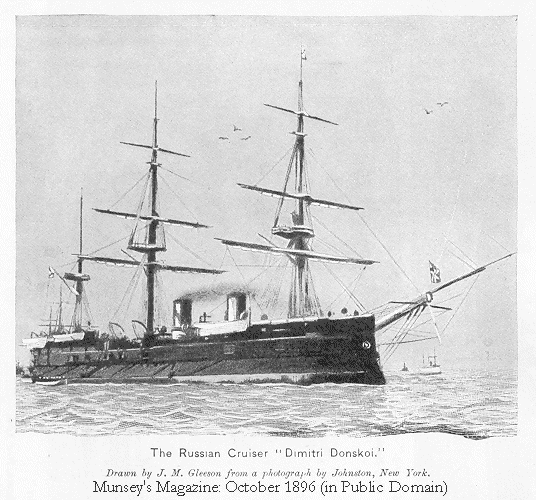Spontoon Island
home
- contact - credits
- new - links - history
- maps - art - story
Navy Ships
circa 1895
Warning: 2 of these graphic
files are large:
Indiana & New
York are approximately 500k.

These illustrations are from a short illustrated article
"Types of Modern Warships" by A.H. Battey
in Munsey's Magazine, October, 1896.
Photo-illustrations are credited on each image.
The illustrations and article are now in Public Domain
and are copyright free. You may re-use them if you wish.
Notes and compilation are edited by Ken Fletcher.
British Battleship Magnificent
390 feet long; 17.5 knots top speed; 4-12" big guns, 12-6" medium guns,
16-12 pounder guns, 12-3 pounder guns, 8 machine guns, 5 torpedo tubes.
(Up until the 1930s most naval ships emphasized a mix of gun sizes,
with no emphasis on anti-aircraft guns. This battleship had armor
plate
protection: in some areas 14 inches thick. Note the leftover masts.
The height of the deck above the water would be good in bad weather.)
United States Battleship Indiana
(large file: 500k)
340 feet long; 15+ knots speed (secrecy!); 4-13" big guns, 8-8"
guns, plus
other secondary guns. (Note the lower distance from deck to waterline.)
Italian Battleship Ruggiero Di Lauria
17 knots; 4-16" big guns
United States Cruiser New York
(large file: 500k)
21+ knots (secrecy!); 6-8" guns, 12-4" guns, plus other weapons.
(In general, cruisers have lighter protective armor than battleships,
faster speed, and a much longer range possible between resupply
ports.
While this class of warship could be part of a fleet,
it is able to operate on its own.)
French Protected Cruiser Jean Bart
19 knots. (This cruiser is a 'commerce destroyer', intended to cruise
out
and hunt for enemy merchant vessels.)
Argentine Cruiser Nueve De Julio
23 knots; 4-6" guns, 5 torpedo tubes. No protective armor plate.
Russian Cruiser Dimitri Donskoi
"Lightly Armored". Steam powered, but also fully rigged with sails.
Spanish Cruiser Infanta Ysabel
14 knots; 4 'heavy' guns; no armor protection. Note sail rigging.
German Dispatch Boat Jagd
20 knots; used as a scout and cruiser
British Torpedo-boat Destroyer Lightning
200 feet long; up to 30 knots; 2 or 3 torpedo tubes, 1-12 pound gun,
4-3 pound guns. (Used to destroy smaller boats carrying 1 or 2 torpedoes.
They are often used to do the torpedo attacking in ocean battles.)
Munsey's Magazine was a popular monthly national magazine,
published in New York. It's emphasis was on upper middle class
popular arts: theater in New York, opera, popular painters, new fiction,
poetry, & the occassional essay on world affairs. Many respectable
pictures of New York actresses and opera singers, and photos of
new paintings that included thoroughly draped models....
In our world, these 1896 ships include some that began a round of
warship upgrades leading up to the First World War.
It seemed to be a 'last chance' time for easy colonialization
enforced by Great Power navies. There were fewer unclaimed
islands to turn into coaling stations for steamships.
The United States navy was in the middle of upgrading the quality
and number of its ships. This was before the Spanish-American War (1898).
In the Spontoon Island universe, these ships would be typical of the
Great Power and Second-world navies at the time (1890s) that
Spontoon became independent. At the time of the Gunboat Wars (circa
1910)
these would have been 'secondary' ships, but still in many national
navies.
Many smaller nations would buy such ships 'used' with some improvements.
In the 1930s, such ships might still be around,
but would be considered obsolete.